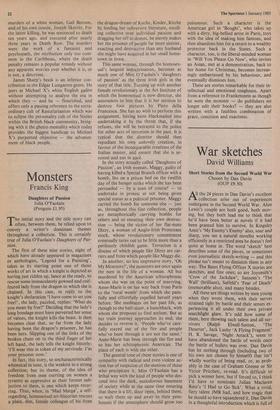Monsters
Francis King
Daughters of Passion Julia O'Faolain (Penguin £1.95)
The initial story and the title story can often, between them, be relied upon to convey a writer's dominant themes throughout a collection. This is certainly true of Julia O'Faolain's Daughters of Pas- sion.
The first of these nine stories, eight of which have already appeared in magazines or anthologies, 'Legend for a Painting', takes as its starting point one of those works of art in which a knight is depicted as having just ridden up, lance at the ready, to rescue some immaculately gowned and coif- feured lady from the dragon to which she is chained. In this case, in reply to the knight's declaration 'I have come to set you free!', the lady, puzzled, replies: 'What do you mean by free?' Deciding that the lady's long bondage must have perverted her sense of values, the knight kills the beast. It then becomes clear that, so far from the lady having been the dragon's prisoner, he has been hers. Slipping one of the links of the broken chain on to the third finger of her left hand, the lady tells the knight bitterly: 'I'll wear this in token of my servitude. I'm your prisoner now.'
In fact, this story, so uncharacteristically whimsical in tone, is the weakest in a strong collection; but its theme, of the idea of freedom from men exerting on women a tyranny as oppressive as their former sub- jection to them, is one which keeps recur- ring. Thus, when, in 'Mad Marga', a self- regarding, homosexual art-historian rescues a plain, dim, female colleague of his from
the dragon-dream of Kuche, Kinder, Kirche by lending her subversive literature, extoll- ing collective over individual passion and dragging her off to demos, he merely makes her the prisoner of people far more sinister, exacting and destructive than any husband she might have acquired in her small home- town in Iowa.
This same woman, through the homosex- ual's languid indoctrination, becomes as much one of Miss O'Faolain's 'daughters of passion' as the three Irish girls in the story of that title. Turning up with another female revolutionary at the Art Institute of which the homosexual is now director, she announces to him that it is her mission to destroy four pictures by Piero della Francesca. She has no wish to perform this assignment, having been blackmailed into undertaking it by the threat that, if she refuses, she will be betrayed to the police for other acts of terrorism in the past. It is typical that the director should then repudiate his own unlovely creation, in favour of the incomparable creations of the Italian master, and ensure that she is ar- rested and out in gaol.
In the story actually called 'Daughters of Passion', an Irish woman, Maggy, guilty of having killed a Special Branch officer with a bomb, lies on a prison bed on the twelfth day of the hunger strike which she has been persuaded — by a man of course! — to undertake in protest at not being given special status as a political prisoner. Maggy carried the bomb for someone else — just as, throughout this fine collection, people are metaphorically carrying bombs for others and so ensuring their own destruc- tion — being the victim of her flat-mate Dizzy, a woman of Anglo-Irish Protestant stock, whose revolutionary commitment eventually turns out to be little more than a perilously childish game. Terrorism is a disease of which people like Dizzy are car- riers and from which people like Maggy die.
In another, no less impressive story, 'Oh My Monsters!', the monsters are once again the men in the life of a woman. All but murdered by the American schizophrenic whom she was on the point of marrying, Anne-Marie is on her way back from Paris to the 'rural womb' from which she pain- fully and effortfully expelled herself years before. She meditates on her past life, as though to the half-sister, a hunchback, with whom she proposes to find asylum. But as her train journey approaches its end, she decides to reverse it. 'People who've care- fully stayed out of the fire and people who've been through it are not the same.' Anne-Marie has been through the fire and so has her schizophrenic American. The place of each is with the other.
The general tone of these stories is one of sympathy with radical and even violent ac- tion but of suspicion of the motives of those who precipitate it. Miss O'Faolain has a lethal way with the kind of people who des- cend into the dark, malodorous basement of society while at the same time ensuring that there is a lift, door open, behind them, to waft them up and away to their pent- houses if the atmosphere should grow too poisonous. Such a character is the American girl in 'Bought', who takes up with a dirty, big-bellied artist in Paris, toys with the idea of making him famous, and then abandons him for a return to a wealthy protector back in the States. Such a character, too, is the liberal-minded woman in 'Will You Please Go Now', who invites an Asian, met at a demonstration, back to her home for Christmas, becomes increas- ingly embarrassed by his behaviour, and eventually dismisses him.
These are stories remarkable for their in- tellectual and emotional toughness. Apart from a reference to Frankenstein as though he were the monster — do publishers no longer edit their books? — they are also written with a faultless combination of grace, concision and exactness.


































 Previous page
Previous page